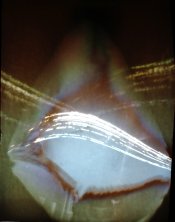VReijs
Member
- Joined
- Sep 11, 2011
- Messages
- 7
- Format
- Pinhole
Hello all of you,
I hope you know the idea of solargraphy , where a pinhole camera is put outside and it records the path of the sun over say 3 months. Below is one picture South_Sun that gives the Sun's path over a few months. Photographic paper was used.
I would also like to do this for the Moon's path (lunargraphy). What I did is that I covered up the pinhole during the day and only 'opened' the camera when a Moon would be visible (some 14 nights).
You can see in the other picture (South_Moon) that nothing is to be seen, while I am sure the Moon was there)...
So the question is, is the paper sensitive enough to expose properly? The Sun is well visible on the paper and say the paper is around ISO 10 to 25. The Sun would expose one particular point on the paper for around 2.5 minutes (due to its width of 0.5 degrees and its movement). The Moon is some 400,000 less in brightness (18.4 diaphragm steps). So what paper sensitivity is needed to get a similar picture for the Moon (or should I use film with what ISO?).
Any ideas are welcome.
Thanks.
All the best,
Victor
I hope you know the idea of solargraphy , where a pinhole camera is put outside and it records the path of the sun over say 3 months. Below is one picture South_Sun that gives the Sun's path over a few months. Photographic paper was used.
I would also like to do this for the Moon's path (lunargraphy). What I did is that I covered up the pinhole during the day and only 'opened' the camera when a Moon would be visible (some 14 nights).
You can see in the other picture (South_Moon) that nothing is to be seen, while I am sure the Moon was there)...
So the question is, is the paper sensitive enough to expose properly? The Sun is well visible on the paper and say the paper is around ISO 10 to 25. The Sun would expose one particular point on the paper for around 2.5 minutes (due to its width of 0.5 degrees and its movement). The Moon is some 400,000 less in brightness (18.4 diaphragm steps). So what paper sensitivity is needed to get a similar picture for the Moon (or should I use film with what ISO?).
Any ideas are welcome.
Thanks.
All the best,
Victor













